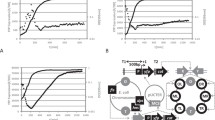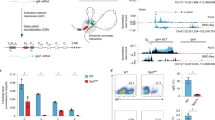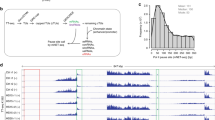Abstract
The transcriptional enhancer effect is used in many, if not all, organisms for remote control of gene transcription. An enhancer DNA can dramatically stimulate transcription of a linked gene from positions either 5′ or 3′ to the gene. Both the proximal promoter and the distal enhancer sequences are binding sites for transcription factors. Interaction between promoter and enhancer is mediated by these factors, presumably via looping out of the intervening DNA. Here we report that the extent of remote activation by an enhancer depends on characteristics of that intervening DNA. Using Beta-globin and SV40 T-antigen test genes, we show that the effect of an SV40 enhancer is transmitted to the responsive promoter, with little or no loss of efficiency, through certain segments of mammalian DNA derived from rabbit β-globin or mouse α-globin gene regions. By contrast, a strong reduction of enhancer activity is observed with certain spacer segments of prokaryotic DNA (from plasmid pBR322 or phage lambda) or sequences of high (G+C) content from eukaryotic genes. We have analyzed more closely sequences that are more or less permissive for transmission of the transcriptional enhancer effect. It appears that these permissive sequences generally have a high (A+T) content and notably a very low abundance of CpG dinucleotides. By contrast, (G+C)-rich DNA segments with high local densities of CpG were the most deleterious for long-range enhancer action. We note that the latter sequence composition is typical for “CpG islands” of many mammalian genes, including housekeeping genes and the human α-globin gene. This may be related to the finding that promoters of most cell type-specific genes, whose activity depends on a strong enhancer, do not contain CpG islands. Most likely, the spacer DNAs of typical cell type-specific genes have evolved to allow maximal transmission of the enhancer effect.
Similar content being viewed by others
Literature cited
Banerji, J., Rusconi, S., and Schaffner, W. (1981).Cell 27:299–308.
Moreau, P.R., Hen, R., Wasylyk, B., Everett, R., Gaub, M.P., and Chambon, P. (1981).Nucleic Acids Res. 9:6047–6068.
Serfling, E., Jasin, M., and Schaffner, W. (1985).Trends Genet,1:224–230.
Maniatis, T., Goodbourn, S., and Fischer, J.A. (1987).Science 236:1237–1245.
Müller, M.M., Gerster, T., and Schaffner, W. (1988).Eur. J. Biochem. 176:485–495.
Wasylyk, B., Wasylyk, C., Augereau, P., and Chambon, P. (1983).Cell 32:503–514.
de Villiers, J., Olson, L., Banerji, J., and Schaffner, W. (1983).Cold Spring Harbor Symp. Quant. Biol. 47:911–921.
Kadesch, T.R., and Berg, P. (1986).J. Mol. Cell. Biol. 6:2593–2601.
Wasylyk, B., Wasylyk, C., and Chambon, P. (1984).Nucleic Acids Res. 12:5589–5608.
Maniatis, T., Fritsch, E.F., and Sambrook, J. (eds.) (1982).Molecular Cloning, A Laboratory Manual, (Cold Spring Harbor Laboratory, Cold Spring Harbor, New York).
Tooze, J. (ed.) (1981).Molecular Biology of Tumor Viruses, 2nd ed.,Revised: DNA Tumor Viruses, (Cold Spring Harbor Laboratory, Cold Spring Harbor, New York).
Weber, F., de Villiers, J., and Schaffner, W. (1984).Cell 36:983–992.
Gluzman, Y., Sambrook, J.F., and Frisque, R.J. (1980).Proc. Natl. Acad. Sci. U.S.A. 77:3898–3902.
Sutcliffe, J.G. (1978).Cold Spring Harbor Symp. Quant. Biol. 43:77–90.
Sergeant, A., Bohmann, D., Zentgraf, H., Weiher, H., and Keller, W. (1984).J. Mol. Biol. 180:577–600.
Picard, D., and Schaffner, W. (1985).EMBO J. 4:2831–2838.
Schirm, S., Jiricny, J., and Schaffner, W. (1987).Genes Dev. 1:65–74.
Banerji, J., Olson, L., and Schaffner, W. (1983).Cell 33:729–740.
Lusky, M., and Botchan, M. (1981).Nature 293:79–81.
Dierks, P., van Ooyen, A., Cochran, M.D., Dobkin, C., Reiser, J., and Weissmann, C. (1983).Cell 32:695–706.
Bird, A.P. (1986).Nature 321:209–213.
Bird, A.P. (1987).Trends Genet. 3:342–347.
Nickol, J.M., and Felsenfeld, G. (1988).Proc. Natl. Acad. Sci. U.S.A. 85:2548–2552.
Garabedian, M.J., Shepherd, B.M., and Wensink, P.C. (1986).Cell 45:859–867.
Godbout, R., Ingram, R.S., and Tilghman, S.M. (1988).J. Mol. Cell. Biol. 8:1169–1178.
Gillies, S.D., Morrison, S.L., Oi, V.T., and Tonegawa, S. (1983).Cell 33:717–728.
Neuberger, M.S. (1983).EMBO J. 2:1373–1378.
Tuan, D.Y.H., Solomon, W.B., London, I.M., and Lee, D.P. (1989).Proc. Natl. Acad. Sci. U.S.A. 86:2554–2558.
Pinkert, C.A., Ornitz, D.M., Brinster, R.L., and Palmiter, R.D. (1987).Genes Dev. 1:268–279.
Hiromi, Y., and Gehring, W. (1987).Cell 50:963–974.
Krimpenfort, P., de Jong, R., Uematsu, Y., Dembic, Z., Ryser, S., von Boehmer, H., Steinmetz, M., and Berns, A. (1988).EMBO J. 7:745–750.
Winoto, A., and Baltimore, D. (1989).EMBO J. 8:729–733.
Probst, E., Kressmann, A., and Birnstiel, M.L. (1979).J. Mol. Biol. 135:709–732.
Yoder, J.I., and Ganesan, A.T. (1983).J. Mol. Cell. Biol. 3:956–959.
Townes, T.M., Chen, H.Y., Lingri, J.B., Palmiter, R.D., and Brinster, R.L. (1985).J. Mol. Cell. Biol. 5:1977–1983.
Courey, A.J., Plon, S.E., and Wang, J.C. (1986).Cell 45:567–574.
Peterson, D.O., Beifuss, K.K., and Morley, K.L. (1987).J. Mol. Cell. Biol. 7:1563–1567.
Kuhl, D., de la Fuente, J., Chaturvedi, M., Parimoo, S., Ryals, J., Meyer, F., and Weissmann, C. (1987).Cell 50:1057–1069.
Sigler, P. (1988).Nature 333:210–212.
Hagerman, P.J. (1988).Annu. Rev. Biophys. Chem. 17:265–286.
Olson, W.K., Srinivasan, A.R., Maroun, R.C., Torres, R., and Clark, W. (1987). InUnusual DNA Structures, (eds.) Wells, R.D., and Harvey, S.C. (Springer-Verlag, Heidelberg), pp. 207–224.
Choi, O.R., and Engel, J.D. (1986).Nature 323:731–734.
Emerson, B.M., Nickol, J.M., Jackson, P.D., and Felsenfeld, G. (1987).Proc. Natl. Acad. Sci. U.S.A. 84:4786–4790.
Kretsovali, A., Müller, M.M. Weber, Marcaud, L., Farache, G., Schreiber, E., Schaffner, W., and Scherrer, K. (1987).Gene 58:167–175.
Author information
Authors and Affiliations
Rights and permissions
About this article
Cite this article
Schreiber, E., Schaffner, W. Long-range activation of transcription by SV40 enhancer is affected by “inhibitory” or “permissive” DNA sequences between enhancer and promoter. Somat Cell Mol Genet 15, 591–603 (1989). https://doi.org/10.1007/BF01534920
Received:
Issue Date:
DOI: https://doi.org/10.1007/BF01534920




